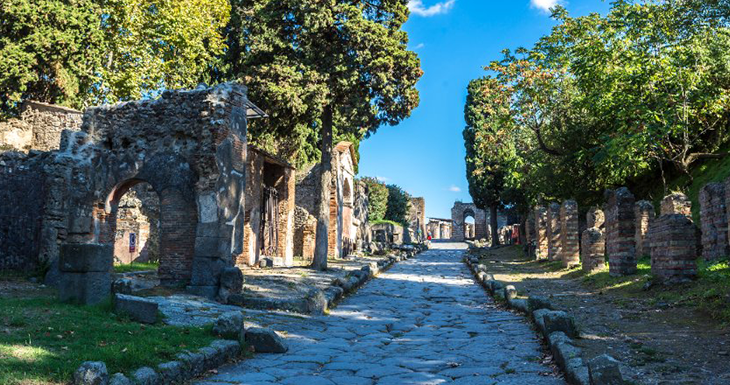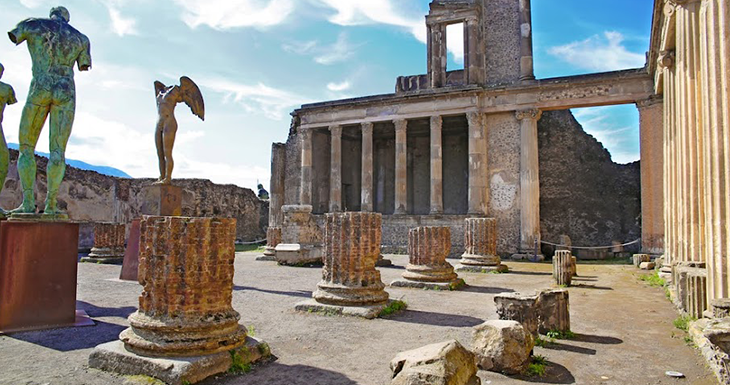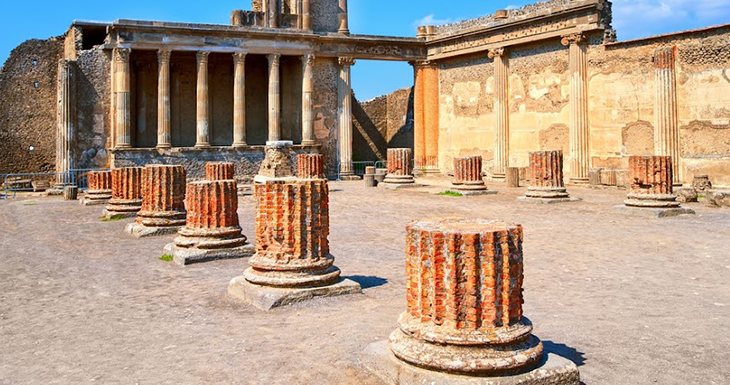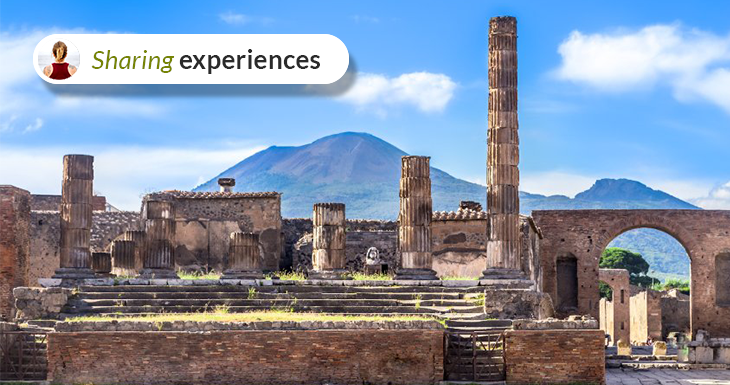Who doesn't dream of walking through a Roman city immobilized in time?
Located in south Italy, this prosperous city went down in history in the year 79 AC. being buried by a mantle of lava and ashes from the violent eruption of the Vesuvius volcano. For centuries the city remained forgotten and it was not until 1550 that it was rediscovered, although excavation work did not begin until 150 years later.
Its history, the mysteries of its destruction and the details of its conservation invited me to travel to the past. This trip is undoubtedly magical.
I arrived in Pompeii on the Circumvesuviana train that leaves from the central station of Piazza Garibaldi in Naples and left me at the Pompei Scavi stop, in just 40 minutes, a few meters from the main entrance of the archaeological site, the Porta Marina.

I recommend wearing comfortable shoes, a bottle of water to refill at the Pompeii fountains, sunscreen and a hat, especially on hot, sunny days like I did. Inside the ruins there are very good cafeterias, with reasonable prices and delicious dishes such as pizza, local salads, pasta, ice cream and coffee.
Although there are routes that can take you up to 7 hours, the average duration of the visit that allows you to complete the list of essential places is shorter. I decided on the 4-hour tour with an archaeologist guide in the afternoon since visiting the city at that time is perfect because most tourists prefer to do it in the morning and many times you have to stand in long lines. On the other hand, in the afternoon the city is almost empty and the experience is more intimate!
My tour began at the House of the Faun, it is one of the most famous buildings to see in Pompeii as well as being one of the largest and most luxurious Roman houses (3000 square meters with two large atriums) in the city. It must have been the residence of a great importance person since they found all kinds of works of art - frescoes and mosaics - that were mysteriously preserved by layers of volcanic ash. And thanks to the cleaning works and restoration of the pieces, they allowed the specialists to deepen their knowledge of the artistic trends, genres and techniques of that time.
I continued walking in the intense sun to El Foro, a square almost 150 meters long surrounded by important buildings and where Pompeii's business, public life, religious activity and justice administration took place. Very close to the forum is the Apollo Temple, another of the most emblematic places. This temple is one of the oldest in the city and today you can see the staircase that leads to a podium and several columns.
Arriving to the oldest part of the city, you will find the Lupanar, the most famous brothel and the most visited place in Pompeii. In this small two-story building discovered in the 19th century, which was not opened to the public until 2006, I could see several rooms with a stone bed and several erotic frescoes painted on the top of each entrance door, as well as inscriptions on the walls made by clients and prostitutes.
In addition to traveling, I am also very passionate about theater, so when the time came to visit the 3 theaters that Pompeii has, I was very excited to see the buildings where religious festivities took place that used to be accompanied by great shows.
The large or Grand Greek-style theater, built in the 2nd century BC, had a capacity for 5,000 spectators distributed on three levels according to social class and was where great works of comedy and tragedy were performed.
The small theater or odeon had a capacity for 1000 people and is one of the best preserved places, with a smaller capacity and better acoustics, it was where musical shows and poetry recitals were held.
The Amphitheater from the year 70 B.C. It was the first built in stone and is the oldest preserved from the Roman civilization, prior to the Colosseum. In this enormous enclosure, the famous fights between gladiators and fights between animals brought from Africa were held, in front of 20,000 spectators.
There are other Roman houses (domus) that I recommend visiting so that your visit is perfect:
- House of the Tragic Poet: this Roman domus from the 2nd century BC. stands out for its beautiful mosaic floors and its frescoes on the walls.
- House of Menander: An image of the Greek poet Menander was found in this luxurious Roman residence and it is one of the best preserved in Pompeii.
- House of Octavius Quartio: in this Roman villa with extensive gardens there are several Pompeian frescoes.
- Casa Dei Quadretti Teatrali or Casca Longus: this domus has a beautiful marble table with lion sculptures and frescoes inspired by works by Euripides and Menander inside.
- Casa della Fontana Piccola: this house stands out for its fountain of the nymphaeum decorated with mosaics and sculptures.

My last stop was in one of the most emotional places in the city, the Orto dei fuggiaschi or orchard of the fugitives, where the casts of 13 people, adults and children, who tried to escape the eruption of the volcano, are kept.
Let us remember that the volcano came to expel more than 10,000 tons of lava per second. In just hours, most of the population died asphyxiated by the gasses of Vesuvius. These molds, in which you can see the faces of terror and the twisted positions of the bodies when they died, were made by filling the cavities left by the bodies with plaster and subsequently removing the layer of hardened ash.
I finished my guided tour with the certainty that I had visited the best open-air museum in the world where I was able to contemplate a city from the 1st century, thanks to the work of archaeologists who continue to discover new buildings and magnificent frescoes (only 60% of the total has been unearthed). ).
This UNESCO World Heritage Site attracts millions of visitors every year. Strolling through the cobblestone streets and entering the ancient Roman buildings of Pompeii will take you back 2,000 years and will surely leave an indelible mark.



